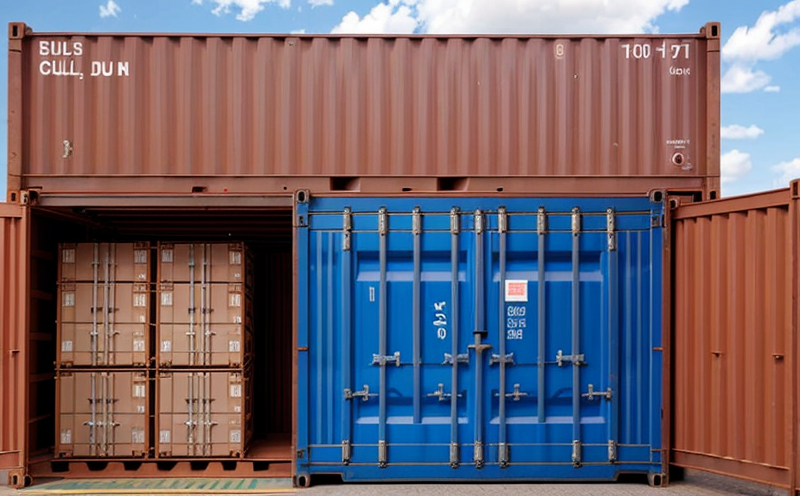USP Shock Resistance Packaging Testing
The United States Pharmacopeia (USP) shock resistance testing is a critical aspect of ensuring that pharmaceutical packaging and container closure systems can withstand the stresses encountered during shipping, handling, and storage. This test evaluates the integrity and performance of containers under dynamic shock loading conditions to ensure they meet regulatory standards for protecting drug products.
Pharmaceutical packaging must be robust enough to safeguard the medication from environmental factors such as temperature extremes, humidity, mechanical impacts, and vibrations. In addition, it needs to protect against contamination while maintaining the product's efficacy and stability throughout its shelf life. USP shock resistance tests simulate real-world conditions that containers might experience during transportation and storage, ensuring they can maintain their structural integrity and seal integrity.
USP testing methods are designed to replicate the forces encountered by pharmaceutical packaging in transit, such as being dropped or shaken. These tests help identify potential weaknesses in design that could lead to leaks or breaches in sterility, affecting product safety and quality. The ultimate goal is to ensure that containers can protect drugs from physical damage while also maintaining their chemical stability.
The USP offers several shock resistance testing methods tailored for different types of packaging materials and closures. These tests are conducted using specialized equipment capable of simulating the dynamic forces exerted on packages during transport. The primary objective is to assess whether a container can maintain its integrity under conditions that could compromise it.
USP shock resistance tests are not only essential for ensuring regulatory compliance but also play a crucial role in enhancing patient safety and product reliability. By identifying vulnerabilities early in the development process, manufacturers can improve their packaging designs and prevent costly recalls or failures once products reach the market.
Scope and Methodology
| Test Parameter | Specification Reference | Description |
|---|---|---|
| Drop Height | USP 681-2020 | The height from which the package is dropped to simulate real-world conditions. |
| Impact Angle | USP 681-2020 | The angle at which the package impacts the surface during testing. |
| Shock Duration | USP 681-2020 | The duration of the impact force applied to the package. |
In this testing method, packages are subjected to controlled drops from specified heights onto a rigid surface. The impact angle and duration can be adjusted based on the specific requirements outlined in USP 681-2020. After each drop test, the package is visually inspected for any visible damage or leaks. If no defects are observed after multiple tests, it passes the shock resistance criteria.
The testing process involves preparing the container according to specified dimensions and specifications provided by USP 681-2020. The specimen must be representative of the actual product packaging being evaluated. Once prepared, the package undergoes a series of controlled drops from varying heights onto a flat surface. The impact is designed to simulate the potential stresses that might occur during shipping or handling.
The test results are typically documented and reported in accordance with USP guidelines. Compliance officers and R&D engineers rely on these reports to make informed decisions about product design improvements, material selection, and packaging strategies aimed at enhancing both safety and efficacy of pharmaceutical products.
Competitive Advantage and Market Impact
Conducting USP shock resistance testing offers significant competitive advantages in the pharmaceutical industry. By ensuring that your product packaging meets or exceeds regulatory requirements, you can enhance brand reputation and trust among consumers and healthcare professionals.
Compliance with USP standards demonstrates a commitment to quality and safety, which is crucial for maintaining market access and avoiding costly recalls. This testing also helps differentiate your products from competitors by showcasing superior design and reliability. In an increasingly competitive landscape where patient safety and product integrity are paramount, such tests can be pivotal in gaining and retaining market share.
The ability to prove that your packaging meets rigorous standards like USP adds value to your offerings, making them more attractive to healthcare providers, pharmacies, and consumers alike. This not only enhances your company's reputation but also fosters long-term relationships with stakeholders who prioritize product safety and efficacy.
Use Cases and Application Examples
The USP shock resistance test is widely applicable across various types of pharmaceutical packaging, including bottles, vials, blisters, and cartons. Here are some specific scenarios where this testing might be used:
Scenario 1: New Drug Launch – During the development phase of a new drug, it's essential to ensure that its packaging can withstand the stresses associated with distribution and storage. Conducting USP shock resistance tests helps identify any weaknesses early on so they can be addressed before commercial launch.
Scenario 2: Material Substitution – If there are plans to change materials used in packaging, whether for cost savings or environmental reasons, it's vital to verify that the new material maintains the necessary shock resistance properties. This ensures compliance with regulatory requirements and protects product integrity.
Scenario 3: Process Improvement – Regularly performing these tests can help monitor changes in manufacturing processes over time. Any deviations from standard performance could indicate issues within the production line that need addressing promptly to maintain quality standards.





